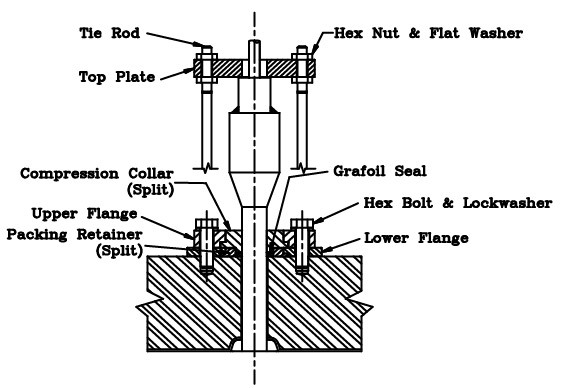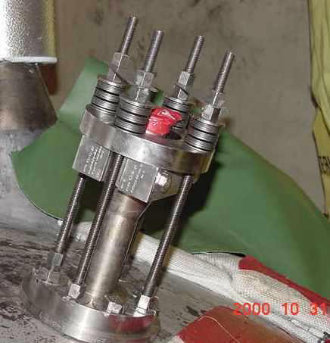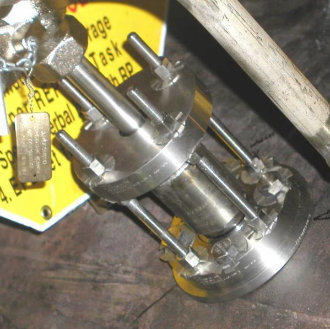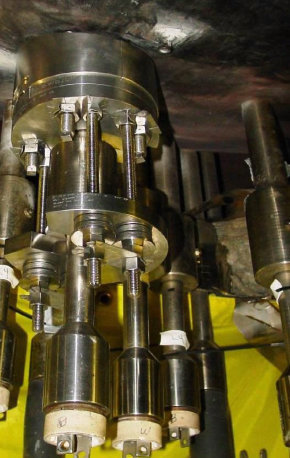Background
Primary water stress corrosion cracking (PWSCC) of Alloy 600 materials and instrument nozzle Alloy 182/82 welds has become a top industry concern for PWR plants. PWSCC has produced significant losses in power generation and attracted considerable regulatory attention.
There are many locations within the reactor coolant pressure boundary (RCPB) that can contain Alloy 600 base metal or weld metal that can be susceptible to PWSCC over time. Additionally, previously replaced instrument nozzles may also leak due to weld flaws.
To reduce utility downtime, Westinghouse has developed a small diameter nozzle Mechanical Nozzle Seal Assembly (MNSA) that can provide a contingency repair solution should an RCPB Instrumentation Nozzle develop a leak.

Mechanical Nozzle Seal Assembly (MNSA)
Description
Typical penetrations throughout the RCPB are located in the following areas:
- Hot Leg Piping Instrument (RTD/PDT) Nozzles
- Cold Leg Piping Instrument (RTD) Nozzles
- Pressurizer Instrument Nozzles
- Pressurizer Heater Sleeves
Westinghouse’s MNSA protects against leakage from the annulus between the nozzle and reactor vessel caused by cracking in the nozzle-to-vessel weld. The MNSA replaces the weld and performs two functions:
- Acts as the primary pressure boundary for the reactor coolant system (RCS)
- Structurally replaces the weld and prevents a potentially failed nozzle from ejecting from the reactor vessel /reactor coolant system
Benefits
Westinghouse’s MNSA has been designed and qualified as a repair for an ASME Section III, Class 1 Pressure Boundary.

MNSA Installed on RCS Piping Instrument Nozzle
The U.S. Nuclear Regulatory Commission (NRC) Code Case N-733 is applicable to the MNSA.
The NRC has accepted MNSA repairs for at least two (2) fuel cycles, allowing MNSA installation on up to NPS 2” RCS Instrument nozzles. After the code case required inspections, the MNSA can be re-installed at the leaking nozzle location.
Westinghouse’s MNSA has the following benefits over a welded repair:
- Installation is performed from outside the vessel without breaching the reactor coolant system (RCS) pressure boundary. Will not require RCS drain-down or core offload
- Installation can be performed on a leaking instrument nozzle
- Installation requires less time and decreased worker dosage than welded repairs
- Mitigates risk of rework for a bad weld
- The entire Instrument nozzle is retained against possible ejection, whereas the welded nozzle repair leaves an original nozzle remnant at the original weld interface
Experience

MNSA Installed on Pressurizer Instrument Nozzle
Westinghouse’s MNSA repair has been implemented on many Combustion Engineering (CE) designed pressurizers and reactor coolant system piping instrument nozzles.
Since 1995, Westinghouse has installed a total of 37 MNSAs at various operating plants. The most recent installation of a MNSA was in 2017.
A similar product also offered by Westinghouse is the MNSA2, which has been utilized on Pressurizer Heater Sleeve and Reactor Pressure Vessel Bottom-mounted Instrumentation (BMI) Nozzle connections. The MNSA seals on the contoured outer surface of the RCPB instrument nozzle interface, while the MNSA2 seals inside a machined counterbore in the RCPB.

MNSA Installed on Pressurizer Heater Sleeve















